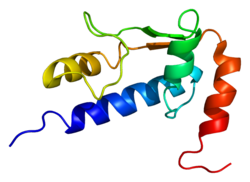GTF2I
Protein-coding gene in the species Homo sapiens From Wikipedia, the free encyclopedia
General transcription factor II-I is a protein that in humans is encoded by the GTF2I gene.[5][6][7]
Function
This gene encodes a multifunctional phosphoprotein, TFII-I, with roles in transcription and signal transduction. Haploinsuffiency (deletion of one copy) of the GTF2I gene is noted in Williams-Beuren syndrome, a multisystem developmental disorder caused by the deletion of contiguous genes at chromosome 7q11.23. It is duplicated in the 7q11.23 duplication syndrome.[8] The exon(s) encoding 5' UTR has not been fully defined, but this gene is known to contain at least 34 exons, and its alternative splicing generates 4 transcript variants in humans.[7] A single gain-of-function point mutation in GTF2I is also found in certain Thymomas. Single nucleotide polymorphism (SNP) in GTF2I is correlated to autoimmune disorders.
Interactions
GTF2I has been shown to interact with:
References
Further reading
External links
Wikiwand in your browser!
Seamless Wikipedia browsing. On steroids.
Every time you click a link to Wikipedia, Wiktionary or Wikiquote in your browser's search results, it will show the modern Wikiwand interface.
Wikiwand extension is a five stars, simple, with minimum permission required to keep your browsing private, safe and transparent.





